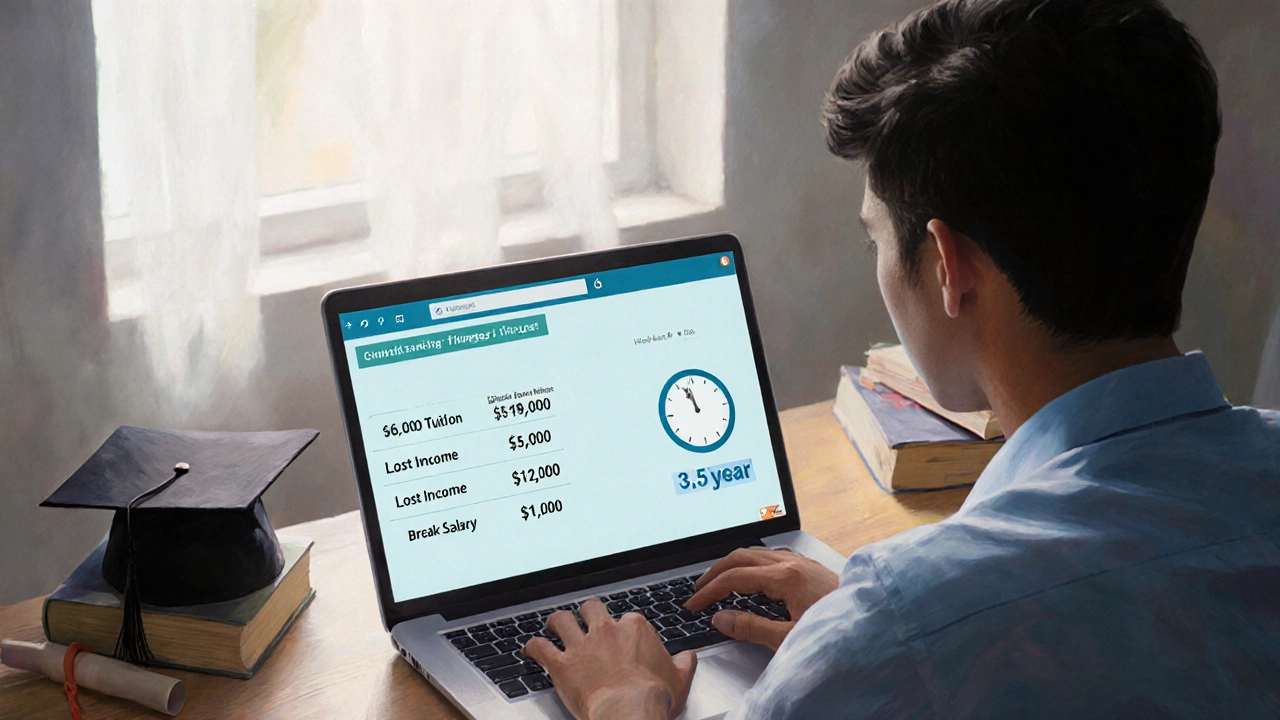MBA Salary ROI Calculator
See if your MBA investment pays off
Enter your current salary, target salary after MBA, and program type to calculate your break-even timeline.
You’ve spent years working, saved up thousands, maybe even took out a loan. Now you’re staring at a $100,000+ price tag for an MBA. The big question isn’t just whether you can afford it - it’s whether it’ll actually pay off in your bank account.
Yes, MBA graduates earn more - but not everyone
Let’s cut through the noise. MBA graduates do earn more, on average. According to the 2025 Graduate Management Admission Council (GMAC) Global Survey of 12,000 alumni, those with an MBA earned 57% more than their pre-MBA salary within three years of graduation. In the U.S., median starting salaries hit $135,000. In Australia, the median was $112,000. In India, it was $48,000. But here’s the catch: these numbers don’t tell the whole story.
That 57% jump? It’s not universal. Someone working in retail management at $45,000 before their MBA might jump to $85,000. Someone already earning $120,000 in engineering at a tech firm? They might go to $150,000 - a nice bump, but nowhere near 57%. The biggest gains go to people who switch industries, roles, or companies. If you’re staying in the same job at the same company, your salary might not budge at all.
Who sees the biggest salary jumps?
Not all MBAs are created equal. The biggest salary increases go to three groups:
- Career switchers: People moving from engineering to consulting, from teaching to finance, from healthcare to tech product management. These roles often require new skills and networks - an MBA gives you both.
- Mid-level professionals: Those with 3-7 years of experience who hit a ceiling. An MBA opens doors to leadership roles that weren’t accessible before.
- International students in high-demand markets: In Australia, Canada, and the U.S., international MBA grads from top schools often land roles in consulting, finance, or tech with salaries 2-3x their home-country pay.
On the flip side? People already in senior roles at Fortune 500 companies, or those in industries with rigid pay scales like public sector or non-profits, rarely see big salary bumps. They might get promoted faster, but the pay increase is often modest - $10,000 to $20,000, not $50,000.
Top schools vs. online MBAs: The gap is widening
Not all MBA programs deliver the same return. The top 20 global MBA programs (like Harvard, Stanford, INSEAD, Melbourne Business School) consistently deliver median post-MBA salaries over $130,000. Graduates from these schools often get recruited by McKinsey, Google, Goldman Sachs - companies that pay premium salaries and offer signing bonuses up to $40,000.
But what about online MBAs? Or part-time programs from less-known schools? The data shows a clear split. Graduates from accredited online MBAs (like those from Indiana University or UNC) see median salary increases of 28-35%. That’s still good - but it’s half the gain of top-tier programs. Programs with no accreditation or low employer recognition? Some show zero salary growth. Employers still value the brand, the network, and the access to recruiting pipelines - things most online MBAs don’t fully replicate.

It’s not just salary - it’s speed and access
Money isn’t the only thing an MBA buys you. Time matters too.
One engineer I spoke to in Melbourne had been stuck as a senior developer for five years. He couldn’t get promoted to tech lead without a management credential. He did a part-time MBA while working. Two years later, he was managing a team of 12. His salary went up $25,000 - but more importantly, he stopped hitting a wall every time he applied for a leadership role. He didn’t need to leave his company. He just needed the piece of paper that said, ‘He’s qualified.’
Same with career pivots. A nurse in Sydney wanted to move into healthcare administration. She had the experience, but no one took her seriously without an MBA. After graduating from a local program, she landed a role at a hospital group managing $8 million in budgets. Her salary jumped 60%. But she also gained credibility. People listened to her in meetings. That’s invisible value - but it’s real.
The hidden costs: Time, stress, and opportunity
Let’s talk about what nobody tells you.
An MBA isn’t just tuition. It’s lost income. If you quit your job for a full-time program, you’re giving up two years of salary. In Australia, that could mean $150,000-$200,000 in forgone earnings. Add living costs, relocation, and exam prep - you’re looking at $250,000+ in total investment.
And it’s not just money. The stress is real. You’re juggling case studies, networking events, job interviews, and personal life. Burnout is common. One survey of 2,000 MBA students in 2024 found that 42% reported severe anxiety during their second semester. Only 18% felt fully supported by their school’s mental health services.
And here’s the kicker: not everyone lands a job right after graduation. In 2025, 12% of MBA grads from non-top-tier schools in Australia were still unemployed six months after finishing. Some took lower-paying jobs just to get back on track.
When an MBA doesn’t make financial sense
Here’s when you should walk away:
- You’re already in a high-paying, high-growth role (like a senior data scientist or project manager at a top firm) and your company doesn’t require an MBA for promotion.
- You’re planning to stay in a field with fixed pay scales - public service, education, or non-profit.
- You’re doing it because your friends are, or because you think it’s ‘what you’re supposed to do.’
- You’re enrolling in a low-ranked, unaccredited program with no employer recognition.
- You can’t afford to lose income for 1-2 years and don’t have savings or sponsorship.
If any of those apply to you, consider alternatives: executive certificates, online specializations in finance or strategy, or even internal mentorship programs. Many companies now offer leadership tracks without requiring an MBA.

Real ROI: How long until you break even?
Let’s do the math. Take a typical MBA in Australia: $65,000 tuition, $50,000 in lost income (two years at $25,000/year), $15,000 in living costs. Total cost: $130,000.
Post-MBA salary: $112,000. Pre-MBA salary: $75,000. That’s a $37,000 annual raise.
Break-even point? 3.5 years. After that, you’re ahead. But if your raise is only $15,000? It takes over 8 years. And if you’re still paying off student loans? That timeline stretches even longer.
Top-tier MBA? Break-even in 1.8 years. Online MBA from a decent school? 5-6 years. A low-tier program? You might never break even.
What to do instead - if an MBA isn’t right for you
You don’t need an MBA to get promoted, switch careers, or earn more. Here’s what works:
- Specialized certifications: PMP, CFA, Google Project Management, AWS Solutions Architect. Many cost under $1,000 and are respected in their fields.
- Company-sponsored training: Many firms pay for leadership courses or tuition reimbursement. Ask.
- Networking + side projects: Build a portfolio. Lead a cross-functional team. Start a podcast or blog on industry trends. Prove you can do the job - don’t just claim you can.
- Executive education: Short programs (4-12 weeks) from top schools like Harvard Online or Melbourne Business School. Often $5,000-$15,000. Gives you the credential without the two-year commitment.
One marketing manager in Sydney skipped the MBA. She took four online courses in digital analytics, led a company-wide campaign that boosted revenue by 22%, and got promoted to director within 18 months. Her salary went up $40,000. No debt. No time off.
Final verdict: Is an MBA worth it?
It depends on your starting point, your goals, and the program you choose.
If you’re early-career, looking to switch industries, and targeting top-tier schools - yes, the ROI is strong. The salary jump is real. The network is priceless.
If you’re already established, in a rigid industry, or considering a low-ranked program - the math rarely adds up. The cost outweighs the benefit. There are faster, cheaper, and less stressful paths to the same outcome.
Don’t chase an MBA because it’s the ‘right thing to do.’ Chase it because it’s the right tool for your specific job - and you’ve done the math.
Do MBA graduates really earn more than non-MBA graduates?
Yes, on average - but not always. MBA graduates from top schools earn 50-60% more than their pre-MBA salaries within three years. However, those in mid-career roles or from lower-ranked programs often see much smaller increases, sometimes under 20%. The biggest gains go to career switchers and those entering high-paying industries like consulting, finance, or tech.
How much does an MBA cost in Australia?
Full-time MBA programs at Australian business schools typically cost between $55,000 and $85,000 in tuition. When you add lost income (two years of salary), living expenses, and fees, the total cost can reach $130,000-$180,000. Part-time or online MBAs cost less - around $30,000-$50,000 - but usually offer lower salary returns.
Can you get a salary increase without an MBA?
Absolutely. Many professionals increase their salary by earning specialized certifications (like PMP or CFA), leading high-impact projects, switching companies, or taking executive education courses. Companies increasingly value proven results over degrees. One survey found that 68% of Australian employers now prioritize skills and experience over MBA credentials for mid-level promotions.
Is an online MBA worth it for salary growth?
It depends on the school. Accredited online MBAs from reputable universities (like UNC, Indiana, or Melbourne Business School) can deliver 25-35% salary increases. But unaccredited or low-ranking online programs often show little to no salary bump. Employers still favor traditional MBAs for leadership roles, especially in finance and consulting. Online MBAs work best if you’re already employed and using the degree to move up internally.
How long does it take to break even on an MBA investment?
For a top-tier MBA in Australia, most graduates break even in 1.5 to 2.5 years thanks to high starting salaries and signing bonuses. For a mid-tier or online MBA, it can take 5 to 8 years. If your post-MBA salary increase is under $20,000 per year, you may never fully recover your investment - especially if you took on debt.

